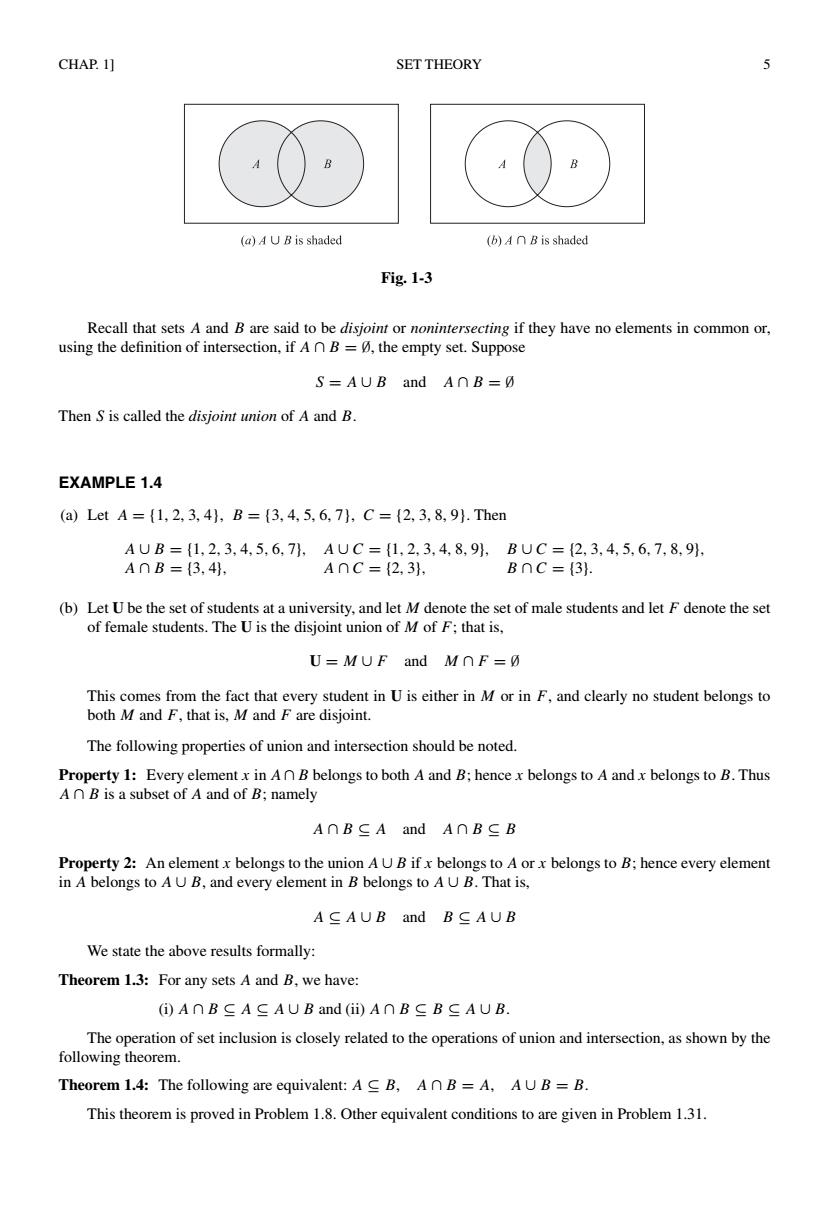正在加载图片...

CHAP.1] SET THEORY 5 (a)A U B is shaded (b)A∩B is shaded Fig.1-3 Recall that sets A and B are said to be disjoint or nonintersecting if they have no elements in common or, using the definition of intersection,if AnB=0,the empty set.Suppose S=AUB and A∩B=O Then S is called the disjoint union of A and B. EXAMPLE 1.4 (a)LetA={1,2,3,4},B={3,4,5,6,7},C={2,3,8,9}.Then AUB={1,2,3,4,5,6,7},AUC={1,2,3,4,8,91,BUC={2,3,4,5,6.7,891, A∩B={3,4}, A∩C={2,3}, B∩C={3. (b)Let U be the set of students at a university,and let M denote the set of male students and let F denote the set of female students.The U is the disjoint union of M of F:that is. U=MU F and MnF=0 This comes from the fact that every student in U is either in M or in F,and clearly no student belongs to both M and F,that is,M and F are disjoint. The following properties of union and intersection should be noted. Property 1:Every element x in An B belongs to both A and B;hence x belongs to A and x belongs to B.Thus An B is a subset of A and of B;namely AnB≤A and AnB≤B Property 2:An element x belongs to the union AUB ifx belongs to A orx belongs to B:hence every element in A belongs to AU B,and every element in B belongs to AU B.That is, A≤AUB and B≤AUB We state the above results formally: Theorem 1.3:For any sets A and B,we have: (①AnB≤A≤AU B and(ii)A∩B≤B≤AUB. The operation of set inclusion is closely related to the operations of union and intersection,as shown by the following theorem. Theorem 1.4:The following are equivalent:A C B,AnB =A,AU B =B. This theorem is proved in Problem 1.8.Other equivalent conditions to are given in Problem 1.31.CHAP. 1] SET THEORY 5 Fig. 1-3 Recall that sets A and B are said to be disjoint or nonintersecting if they have no elements in common or, using the definition of intersection, if A ∩ B = ∅, the empty set. Suppose S = A ∪ B and A ∩ B = ∅ Then S is called the disjoint union of A and B. EXAMPLE 1.4 (a) Let A = {1, 2, 3, 4}, B = {3, 4, 5, 6, 7}, C = {2, 3, 8, 9}. Then A ∪ B = {1, 2, 3, 4, 5, 6, 7}, A ∪ C = {1, 2, 3, 4, 8, 9}, B ∪ C = {2, 3, 4, 5, 6, 7, 8, 9}, A ∩ B = {3, 4}, A ∩ C = {2, 3}, B ∩ C = {3}. (b) Let U be the set of students at a university, and let M denote the set of male students and let F denote the set of female students. The U is the disjoint union of M of F; that is, U = M ∪ F and M ∩ F = ∅ This comes from the fact that every student in U is either in M or in F, and clearly no student belongs to both M and F, that is, M and F are disjoint. The following properties of union and intersection should be noted. Property 1: Every element x in A ∩B belongs to both A and B; hence x belongs to A and x belongs to B. Thus A ∩ B is a subset of A and of B; namely A ∩ B ⊆ A and A ∩ B ⊆ B Property 2: An element x belongs to the union A ∪ B if x belongs to A or x belongs to B; hence every element in A belongs to A ∪ B, and every element in B belongs to A ∪ B. That is, A ⊆ A ∪ B and B ⊆ A ∪ B We state the above results formally: Theorem 1.3: For any sets A and B, we have: (i) A ∩ B ⊆ A ⊆ A ∪ B and (ii) A ∩ B ⊆ B ⊆ A ∪ B. The operation of set inclusion is closely related to the operations of union and intersection, as shown by the following theorem. Theorem 1.4: The following are equivalent: A ⊆ B, A ∩ B = A, A ∪ B = B. This theorem is proved in Problem 1.8. Other equivalent conditions to are given in Problem 1.31